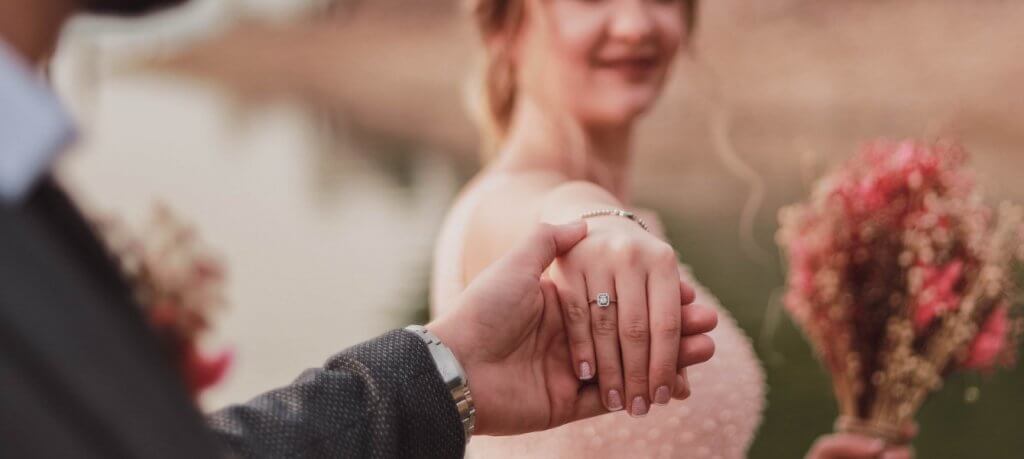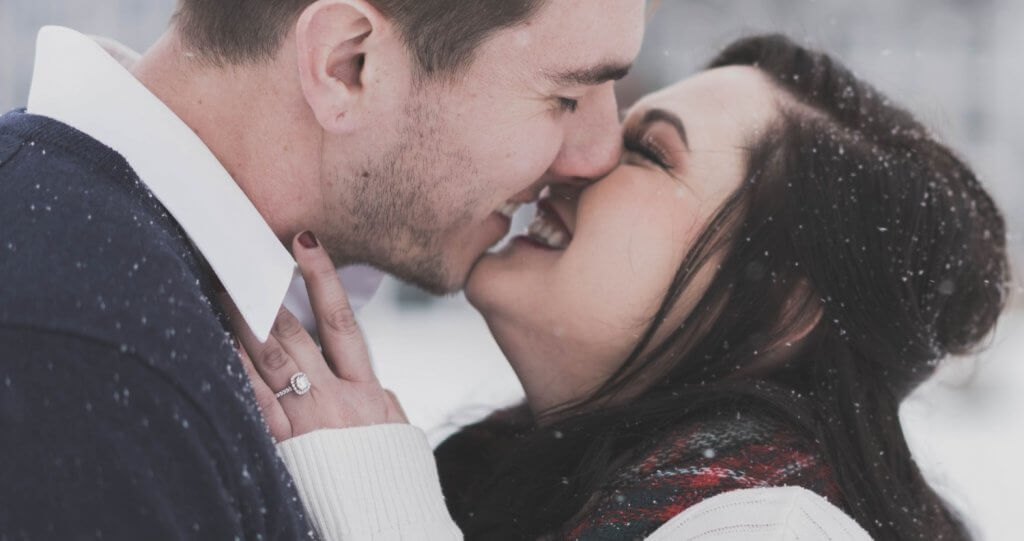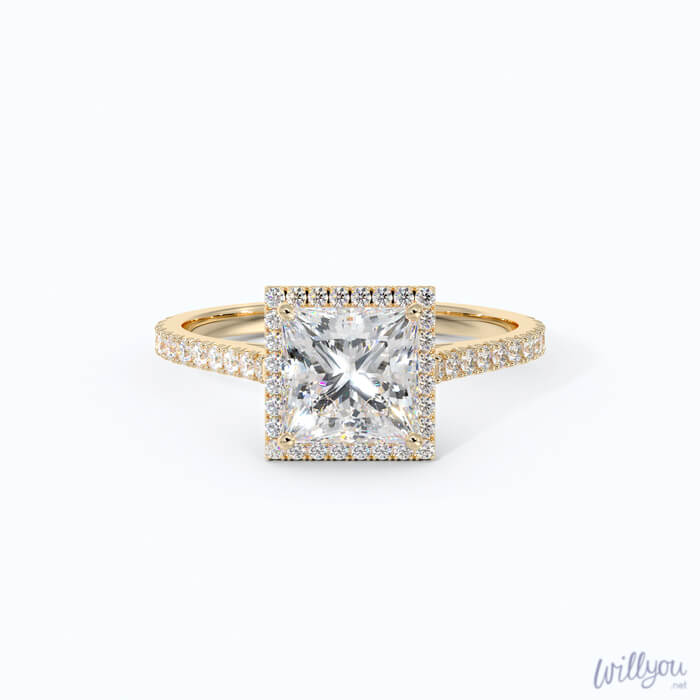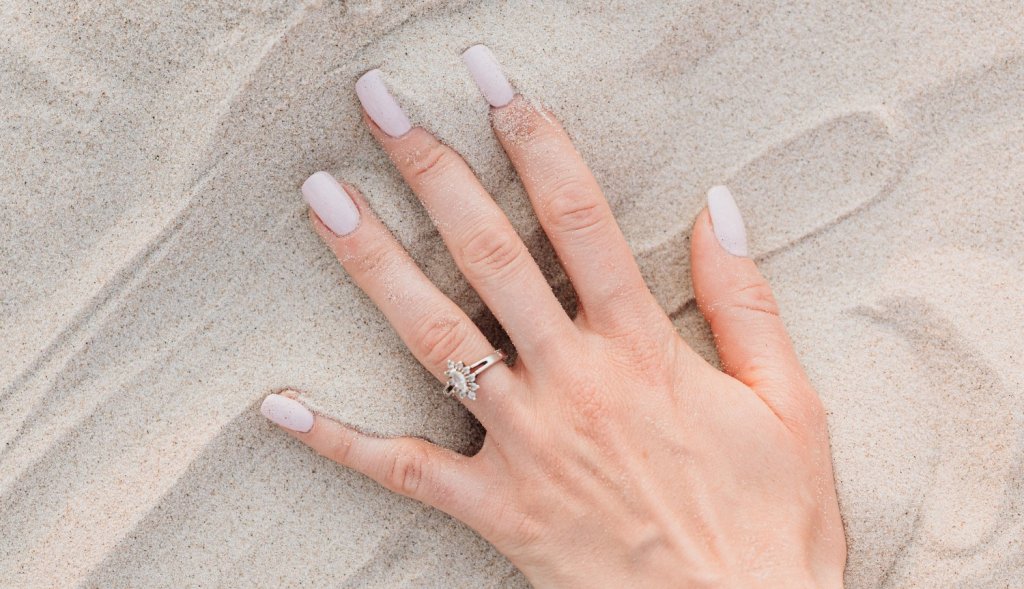Square Halo Engagement Rings: The Complete Guide
Key Takeaways
- Halo ring settings are some of the most popular features in engagement ring design.
- If you are looking for something outside of the box, however, they can be seen as a bit mainstream and “safe”.
- The square halo is a little different.
- It is a square of melee diamonds, used to frame the ring’s main diamond.
- They offer better protection, extra sparkle and good color enhancement.
- The issues with this setting, however, is that they can snag and can sometimes make a diamond look smaller than it actually is.
- Halos are a classic design, and the square halo offers a different spin on it.

Halo ring settings are among the most popular features to incorporate into your engagement ring design. Sure, there are times when they are in style more than other times but, even when they’re not at the height of bridal fashion, most jewelers would agree that they remain one of the most popular choices for shoppers.
Halos are, as the name suggests, typically round – a circle of small, bright diamonds designed to add an extra glitter of brilliance and fire, and to accentuate the center stone without eclipsing it. In fact, halos can often give the impression of the diamond at your ring’s center being bigger, brighter, and even more impressive.
But, on the flipside, the ongoing popularity of the halo means that it’s a common sight – something relatively ‘safe’ and expected, particularly these days. For that reason, more shoppers are looking for ways to hit refresh on the halo.
The square halo is a little edgier – a little less expected – and a great way to uncover a whole new side to this popular setting.
The Square Halo – What You Need to Know
True, the name sounds like something of a contradiction, but that is part of this design element’s charm. It’s unexpected, new, and different enough that people will do a double-take when it passes through their gazes.
What is a Square Halo Ring?
As you have probably guessed by now, the square halo is, literally, a square of melee diamonds (the sort of tiny diamonds used in pavé settings and round halos) used to frame a ring’s main diamond. The square halo might be placed level with this diamond, or it might sit a couple millimeters below.
Halo rings first rose to popularity in the early 1920s, around a century ago. The design of the halo offered a sleek, geometric alternative to the flower settings that had been popular during the Victoria era, and likely remained prominent well into the first half of the twentieth century for that reason.
Halos can comprise a single row of diamonds, or multiple rows, which will be referred to as double or even triple halos. Keep in mind that with every halo added to a design, the risk of the diamond being overwhelmed increases. Even a particularly large diamond will have a limit as to how many halos it can accommodate before it starts to become a shrinking violet under all those melee diamonds.
The exact same thing holds true for square halos, and the number of rows you choose to incorporate into the design will have a major impact on how much your primary diamond stands out.
Square Halo Benefits
The square halo shares a lot of the same benefits as the round halo, but also offers a few additional selling points of its own.
- Protection
Just like the traditionally round halo, the square halo offers a little extra protection to your diamond. If it is designed to sit flush with the edges of the diamond, then it prevents the girdle from getting knocked, and generally acts as an additional line of defense between the diamond and the rest of the world. - Extra Sparkle
Melee diamonds don’t react to light in the same way as larger diamonds, which means that there will be an attractive contrast between the light performances given by the halo and ring’s main diamond. While the square halo will glitter, the main diamond will sparkle, creating a very captivating combination of brilliance and fire that tends to seal the deal for most shoppers on the fence between halo vs no halo. - Color Enhancement
This one isn’t a guarantee unless the diamonds used in your square halo are carefully chosen to sit one- or two-color grades below your main diamond (without straying beyond a J color grade, of course). You’ll want to stick within the Near Colorless range but, provided the diamonds of your halo are lower on the scale, your main diamond should appear even closer to colorless. This is great if you’re concerned about a slight yellow tint in your stone. - A Larger Center Setting
We’re not going to advise that you go for a smaller diamond if you’re planning on adding a halo into the design, because the halo’s complementary effect isn’t a miracle worker – and having too small a diamond in the center can create the appearance of a cluster ring, rather than a halo setting. But, at the same time, it’s nice to add a little extra bulk to that center stone, and the halo is the best way of achieving that. As you can imagine, this is more effective if the halo follows the shape of the diamond: a round halo for a Round Brilliant, for instance, or a square halo for a Princess. - A Bold Statement
The halo setting has created many beautiful designs, but it’s something we’re all used to seeing. That’s not necessarily a bad thing – after all, we’re all used to seeing the Solitaire more than any other, and it hasn’t lost any of its original power or appeal as a result of its prevalence – but some shoppers are looking for something a little less obvious. The square halo is a great way to go against the grain, without going too ‘wacky’ or novel. - It’s Flattering
It’s a basic truth of ring design: larger, bulkier ring settings (and bands) naturally make the finger appear slimmer, while particularly small diamonds and center settings tend to have the opposite effect. A halo adds a few millimeters all the way around your diamond, making the center setting significantly larger. Obviously, choosing a ring style simply because of its slimming/flattering effect on the wearer needn’t be a priority when you’re shopping for an engagement ring, but some people do naturally gravitate toward designs that offer this benefit.

Square Halo Disadvantages
Even the simplest ring designs have a couple of downsides to them. You don’t need to be discouraged by the disadvantages, but you will want to understand them before you commit.
- They’re Not Always at the Height of Popularity
We’ll caveat this by saying that popularity and trends don’t need to matter one iota, especially not when the ring has so much sentimental value attached to it, so you can skip over this disadvantage entirely if you want. It matters to some people, particularly if their style favors the more timeless pieces: solitaires, cathedrals, or accents that don’t totally envelope the diamond. - They Can Snag
This one is more of a problem for square halos than their circular counterparts, since they feature four corners that can easily snag on clothing, the lining of her purse, or her hair. Some square halos have rounded or beveled corners (more on that below), while others are sharper, like the corners of a Princess cut diamond, so consider the benefits of a softer shape if your partner has a busy lifestyle. - They Can Sometimes Make a Diamond Look Smaller than it is
True, we’ve already stated the opposite – that halo settings can make a ring appear bigger – but there is more than one way to design a halo, and the wrong design can be a little less complementary to a smaller diamond. If the melee diamonds used in the halo are on the larger side, of if you add too many layers to the halo, the diamond can be overwhelmed by the bulk of the setting and look a little lost in the midst of all those smaller diamonds. That’s why it’s always a better idea to design a custom ring with your jeweler, rather than shopping a premade design and having your own diamond set within it. - It Can be Harder to Find a Wedding Band that Accommodates the Halo’s Shape
Chances are, you’re not thinking too much about the wedding band yet, but it’s worth considering how another ring will sit alongside the engagement ring when the time comes to say, ‘I do’.
Don’t panic yet, because the popularity of halos has meant that plenty of wedding bands are designed to follow the curve of the setting, rather than sitting uncomfortably alongside or underneath. The square halo, being a little less common than the round, can be a tad tricker to accommodate, but it’s still possible.
Your best bet will be to return to the same jeweler who designed and made the ring in the first place. They will be able to create a one-of-a-kind band that fits the halo like a puzzle piece and doesn’t rub against it uncomfortably.
Diamond Shape
While you may be used to seeing halos, they have a totally unique impact on each diamond shape they are paired with. Here are some ideas to spark your imagination…
Pairing a Square Diamond with Square Halo Settings
The square halo is an obvious choice for the Princess cut, the Cushion Cut, and the Asscher – and, in all likelihood, those three shapes account for the majority of square halos being created today – but it’s not limited to them, either.
Asscher Cut Square Halo Engagement Rings (Square Emerald)
Halos are almost invariably made from Round Brilliant diamonds – a shape which is pretty much the polar opposite of the Asscher. While the Asscher features a bold, geometric, Art Deco-style step cut (and a reserved, elegant shine) the Round Brilliant features a complex pattern of facets, all designed to maximize the amount of sparkle the shape yields.
Combining the two, you get the best of both worlds – and, more importantly, a beautiful, fresh design that shows off every one of a diamond’s innate features. It’s not all that common to see an Asscher halo engagement ring, primarily because the Asscher (or square Emerald) is a lot less popular than many other diamond shapes.
But, in spite of its rarity, a square halo Asscher engagement ring is a strong choice – particularly if your partner’s tastes tend to align with the old-world glamour of the 1920s.
Cushion Cut Square Halo Engagement Rings
Cushion cut diamonds are valued for their fire, which creates a gorgeous, opulent effect on the finger. Add a halo into the mix, and you’ve got a truly magnificent combination of sparkle on your hands (literally).
Since Cushion cut diamonds are widely known for their tendency to show color more than other shapes, a halo comprising carefully chosen diamonds of a slightly inferior color grade (again, still from the Near Colorless group) can be very useful for elevating the center stone’s appearance and making any slight trace of color far less noticeable.
You might choose to echo the soft corners of the cushion within your halo, or pair the shape with a more angular square halo – reminiscent of the Princess cut (more on that below). There’s a lot of versatility with the Cushion, particularly if you’re open to straying from the 1:1 square ratio and embracing an elongated Cushion shape instead.
Princess Cut Square Halo Engagement Rings
After the Round Brilliant, the Princess cut represents one of the most popular diamond shapes out there for engagement rings. Its facet pattern and bold, modern shape make it a strong choice among shoppers looking for something that is equal parts contemporary and romantic – something bright and brilliant but contained within a chic silhouette.
In a more practical sense, the protection offered by the halo is very handy for Princess cut diamonds. Their four corners are pretty vulnerable to chipping – much more so than, say, the rounded corners of the Cushion cut – and the halo can act as a useful buffer between the diamond’s corners, and the everyday knocks, bumps and scrapes any diamond ring will go through.
Pairing a Princess cut with a halo creates a highly feminine, highly luxurious design that will accentuate the distinctively sharp corners of the shape, while also offering them protection, and creating that appealing contrast between the square center diamond, and the Round Brilliant melee diamonds.

Pairing a Round Diamond with Square Halo Settings
It may sound a little counterintuitive, but pairing a Round Brilliant with a square halo, rather than one that closely hugs the girdle of the diamond, is a simple but powerful change from the norm.
For starters, it means that you can achieve the modern shape of the Princess or Cushion cuts (depending on whether the sides of your halo are straight, or gently curved), without losing any of the brilliance and fire of the Round Brilliant. Often, shoppers feel compelled to stick with the Round Brilliant – even if they like the silhouette of a different shape – because of the superior sparkle it offers, so the halo represents the perfect option for marrying the two shapes together.
As always, you’ll want to aim to maintain a good size difference between the Round Brilliant diamond and the melee diamonds that comprise the square halo. If not, you could inadvertently wander into ‘cluster ring’ territory, which will have the opposite effect, and make your center stone appear smaller than it really is.
Keep in mind that combining the Round Brilliant with a square setting will inevitably lead to some lost definition of the original shape. If you’re picking a square halo, then chances are that you’re not concerned about retaining the round silhouette of the center stone, but it feels important to point it out regardless.
Combining round diamond with square halo is definitely a break from tradition, and you might struggle to find a broad selection to gather inspiration from, but a good jeweler will be up to the task of drawing up a unique design – one that lives up to the beauty of each element equally.
Our Summary
Halos are a true classic of engagement ring design. Those extra flashes of fire and brilliance continuously traveling the halo’s length are a convincing argument in favor of this feature before we even say a word about their other benefits, and their versatility means that they suit many different styles, and diamond shapes.
It’s great to know that the square and rectangular diamond shapes can be set within halos, just like the Round Brilliant and Oval, but it’s also great to know that you don’t have to be confined to ‘putting round pegs in round holes’. Combining the square halo with a non-square diamond shape is a great way to go off-piste, and to creating a unique ring that still looks beautiful and feels protected against the wear and tear of everyday life.

Mar 13, 2022 By Willyou.net
What is a Diamond Accent? Everything You Need to Know

Aug 17, 2021 By Willyou.net
The Pavé Setting: The Complete Guide








